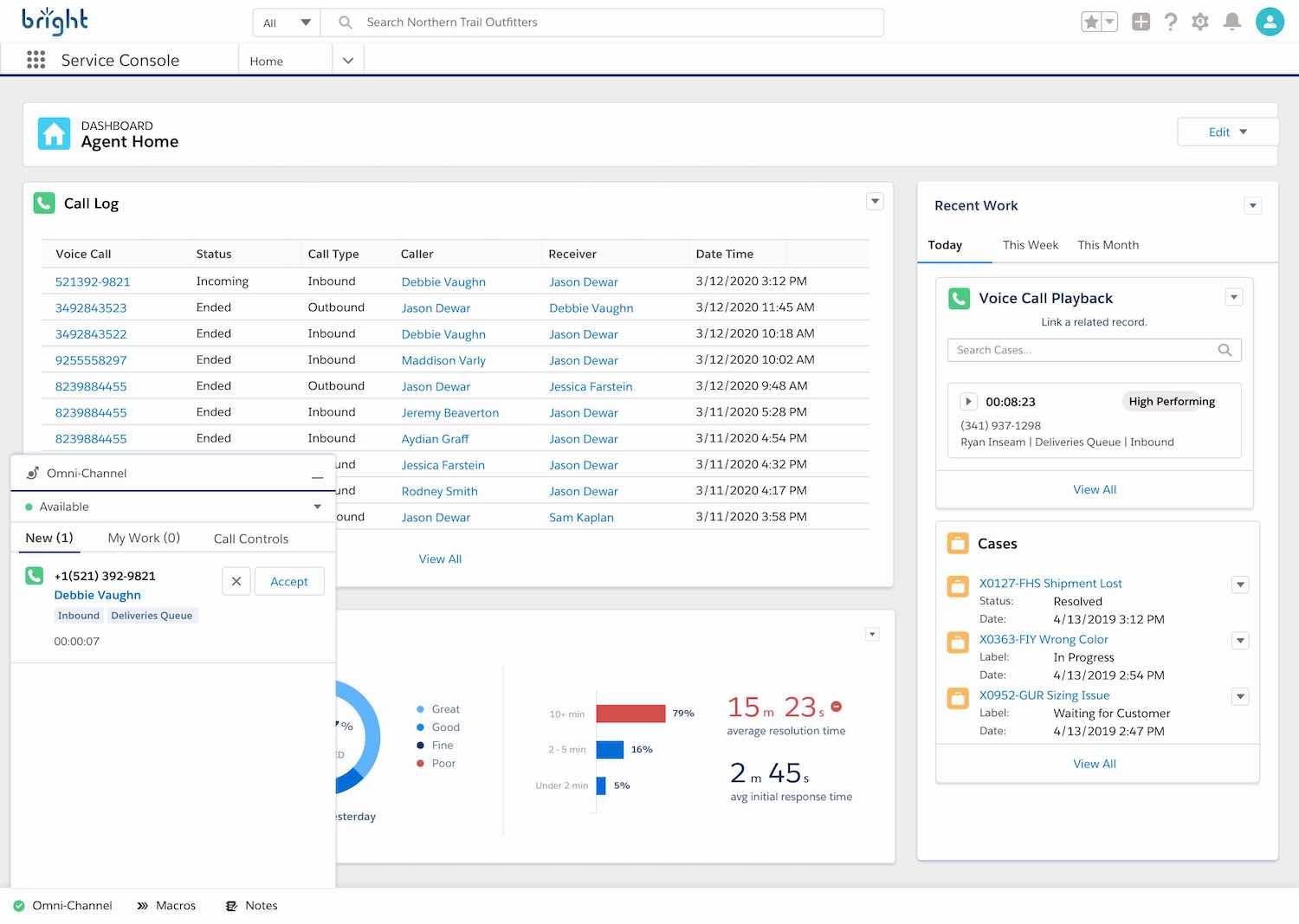Customer Service Is About People, Even When It’s Powered by Technology



This company relies on Service Cloud Voice to scale their customer service and support employees.

Julie ODonnell
It’s always stressful to start a new job. But imagine starting a new job right before COVID-19 turned the world upside down? That’s what I did.
In February, I joined connectRN, a staffing company that uses technology to place nurses in healthcare facilities. I was excited to bring my experience in technology, healthcare, and customer service management to the role of team lead of customer success and manage a growing team of high-energy service agents.
Then COVID-19 happened. Demand for nurses skyrocketed and our agents’ phones rang off the hook. Our weekly case volume went from approximately 1,500 per week in early March to more than 4,000 a week by early June.
Unfortunately, our existing communications platform wasn’t performing. Call quality was poor. Data was missing, inaccurate, and spread around disconnected systems, which impacted productivity, visibility, and reporting. There were too many manual processes, including limitations around searching for call recordings. In addition, we were frustrated with the vendor’s level of support.
Understandably, our agents’ stress levels grew. Though they’re experienced in crisis management, our nurses were dealing with COVID-19 on the front line and needed a lot of support.
We needed better tool efficiency, stronger processes, and a whole lot of love and stamina.
To solve technology and process challenges, we dialed into Salesforce Service Cloud Voice as an early adopter to improve data accuracy and visibility, boost agent productivity, and provide amazing customer support. And while we always prioritize our agents’ well-being, we now lean more into empathy, coaching, appreciation, and other ways to support and enable them to continue to deliver exceptional service.
Here are some benefits we’re seeing from Service Cloud Voice to date, along with tips for how to scale your service platform and support your employees in today’s world.
Answer the call with Service Cloud Voice
We already had Salesforce Service Cloud in place and I’m a Certified Salesforce Administrator, so we were able to get up and running with Service Cloud Voice quickly. Though we’ve only been using Service Cloud Voice for a short time, we see benefits from its automatic transcription functionality and centralized omni-channel view.
In the past, calls that were 30-60 seconds long didn’t always get captured. Sometimes cases weren’t created by our existing system, or our agents forgot to manually log them because they’d been resolved. This skewed our data and provided incomplete histories of our conversations with nurses. Service Cloud Voice’s real-time transcription accurately captures what our customers are saying and frees up our agents to focus on listening to their needs instead of furiously taking notes or doing data entry later.
As a manager, I now have a centralized omni-channel view of my call center. I can easily access the call transcriptions in the Service Cloud console instead of hunting around multiple systems. I have quick visibility into what customers call about to understand their issues better and plan for agent training and coaching.

Choose the service platform that’s right for your team
While we ultimately chose Service Cloud Voice, deciding to migrate to a new service delivery system involves careful planning and thoughtful implementation. After all, it’s a big commitment, which impacts both your employees and customers.
Here are five things to think about before scaling up your service technology:
1. Identify requirements
You need a solid understanding of your requirements across all teams — agents, management, IT — that might use the technology. It’s easy to forget that there may be a few cases that might not fit well, so keep an eye out for that. Be sure to align with all stakeholders from the get-go. We did this by identifying key players, asking them for their specific requirements, and then holding a planning meeting.
2. Make a list
Make a clear list of must-haves versus would-likes. We had a lot of must-haves — like capturing data accurately and having it easily accessible on one platform. If there is functionality that you absolutely can’t live without, a list makes it easier to narrow down the vendors to consider.
3. Set a flexible budget
Clearly, budget is a consideration. But keep in mind that sometimes what you pay for a service can save you money in staffing in the long run. It can also increase revenue overall through solid customer success and customer retention.
4. Review implementation and onboarding costs
Look at the implementation and onboarding costs associated with the new system and consider these questions. Are those costs worth it? Do you have any internal resources you can rely on to carry some of that configuration weight? Will that be efficient enough or cost you more in the long run if things don’t go well? Being a Salesforce Administrator helped our implementation go faster and made it more cost-effective. If you’re interested in becoming a Salesforce Administrator, get started with Admin Beginner on Trailhead, Salesforce’s online learning platform.
5. Start slow
Don’t shoot for every bell and whistle right out of the gate. Get the basics of what you need to function and then add iteratively. Less complexity is easier to adjust initially, and as you see how things are working and know what your needs are, you can build from there. Service Cloud Voice has a lot of functionality, but right now, we’re focusing on its artificial intelligence transcription and how it’s helping us get accurate data.
Support your team to set them up for success
Technology is just part of how you empower your service team — and Service Cloud Voice is already making a difference at connectRN by creating automated transcriptions and providing an omni-channel view. People deliver service, so you must set your team up for success with positive support — especially now.
Here are four ways you can build customer service skills and keep morale high:
1. Invest in coaching and training
Soft skills, like communication, problem solving, and listening, are always important in customer service, especially healthcare. Make coaching and training a priority. As a Salesforce Service Insider Elite Community member and Ranger, I use Trailhead to help both my team and me develop the skills we need to succeed in this challenging time. Check out the Trailmix, a collection of learning modules, I created for my team.
2. Foster a sense of camaraderie
Customer success is at the heart of any good company. Make sure each person feels like an individual, part of the team, and the whole company. Empower them to share ideas and implement those ideas where appropriate. Give credit, too!
3. Use humor and encourage transparency
Let your team joke and vent to foster encouragement. And join in, so your team knows you’re right there with them. Since we now deliver service from home at connectRN, Slack is our lifeline for communication. We also use Zoom meetings and encourage everyone to turn on their cameras so we can see their face. These practices and tools make it possible to build relationships in a remote world.
4. Show appreciation
Show appreciation for your team, every single day! Give private encouragement one on one, public recognition in a Slack channel, or a surprise small gift here and there. All these things go a long way to keeping morale up, which is paramount given today’s circumstances.
Turn up the volume on service with technology and people
At connectRN, we believe nurses are at the heart of healthcare. It’s now even more critical for us to deliver great customer service as demand for nurses grows during COVID-19. We handled 13,000 cases in September, a 63% increase in case loads from pre-Covid! With Service Cloud Voice, we mitigated challenges with our previous system and saw benefits, like improved data accuracy through automated transcription and an omni-channel view from a single platform. We also continue to support our employees with coaching, laughter, and more.
See how Service Cloud Voice can keep service at the heart of your organization during a crisis or anytime.























